Yaar Punjabi
Prime VIP
The Battle of Saragarhi
12th September marks the Battle of Saragarhi that took place in 1897. It is the incredible story of 21 Sikh soldiers against the ferocious Pathan (Afghan) tribesmen, numbering close to 10,000. The staggering ratio of 1: 416 stacked against the Sikhs was both unmatched and unprecedented, making their "last stand" at Saragarhi as the greatest odds faced by any troops in the history of modern warfare. The Battle at Saragarhi is one of eight stories of collective bravery published by UNESCO (United Nations Educational, Scientific and Cultural Organization). It has been mentioned as one of the five most significant events of its kind in the world which includes the Saga of Thermoplyae associated with the heroic stand of a small Greek force against the mighty Persian Army of Xerxes in 480 B.C.
The Battle of Saragarhi
12th September marks the Battle of Saragarhi that took place in 1897. It is the incredible story of 21 Sikh soldiers against the ferocious Pathan (Afghan) tribesmen, numbering close to 10,000. The staggering ratio of 1: 416 stacked against the Sikhs was both unmatched and unprecedented, making their "last stand" at Saragarhi as the greatest odds faced by any troops in the history of modern warfare. The Battle at Saragarhi is one of eight stories of collective bravery published by UNESCO (United Nations Educational, Scientific and Cultural Organization). It has been mentioned as one of the five most significant events of its kind in the world which includes the Saga of Thermoplyae associated with the heroic stand of a small Greek force against the mighty Persian Army of Xerxes in 480 B.C.

Saragarhi
Saragarhi was a communication relay post between Fort Lockhart and Fort Gulistan in the Sulaiman Range of the North Western Front Province. Since Lockhart and Gulitsan were not in a visual line of sight due to geographical attributes, a midway heliograph communication post (communication by capturing sunlight with a mirror and transmitting it via coded messages) was built at Saragarhi. The Saragarhi post was vital in ensuring the survival of these two Forts in specific and the defence of the region, in general.
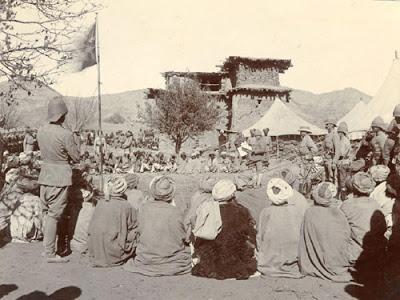
Resistance from Local Tribes
The last decades of the 19th century the Russians were trying to make inroads into the Indian continent via Afghanistan and the British had to make several incursions into Afghanistan to prevent Afghan tribes allied with the Russian from taking over. In order to this the British used posts constructed by Maharaja Ranjit Singh, during his Western campaign. Constant raids and skirmishes by violent and bloodthirsty tribesmen were a regular occurrence and the British Indian Army was in constant vigil. Castration, mutilation and skinning captured soldiers alive was one of the many ways tribal leaders instilled fear and control.

Sikhs Soldiers in the British Army
The relationship between the Sikh soldiers and the British Army started out of mutual admiration for each others' courage and tenacity in the battle during the First Anglo-Sikh War (1839-45) and the Second Anglo-Sikh War (1845-49). The inclusion of Sikh soldiers in the British Army was a testament to that admiration. The British recognised that the bravery, honesty, integrity, and fearlessness of the Sikh soldiers came from their faith, the Amrit they had taken and the Rehit (code of conduct) thay lived by, and therefore only Amritdhari Sikhs who prescribed to Rehit were enrolled in the army.

Plan for Attack
Before 12th September, numerous attempts were made by the Pathans to overrun the post but they failed due to calculated defensive actions by the Sikhs under the able leadership of Havildaar Ishar Singh, the detachment commander at Saragarhi. Unknown to the Sikhs, the Pathans were planning a major attack set for 12th September 1897 at 9am to destroy this vital post. The Pathan strategy was to block the reinforcement from Fort Lockhart and strike Saragarhi with no mercy. Havildaar Ishar Singh peered through his binoculars from the watch tower of his post. Through the magnified view, he could see columns upon columns and row upon rows of Pathans waving their swords and guns violently at the Sikhs. The dust kicked up by the thousands of horses temporarily blocked the sun rising over the horizon. The Pathan forces assembled before the Sikhs who were raring to go.

Call for Back-up
Sepoy Gurmukh Singh, the detachment signaller, began signalling to Fort Lockhart about their position: "ENEMY APPROACHING THE MAIN GATE ... NEED REINFORCEMENT". Lt Col Haughton, Commanding Officer of 36th Sikh Battalion, rushed his troops to help the outnumbered Sikhs but the Pathans had cut-off the supply route between Fort Lockhart and Saragarhi so that the Sikhs would be stangled into submission. Fort Lockhart transmitted back: "UNABLE TO BREAKTHROUGH ... HOLD POSITION". Saragarhi flashed back: "UNDERSTOOD". With that message, Lt Col Haughton had sealed the faith of the Sikhs at Saragarhi to certain death. As he watched from Fort Lockhart, Haugthon with his own eyes counted at least 10 enemy standards (each representing 1,000 tribesmen) facing the 21 Sikh soldiers.
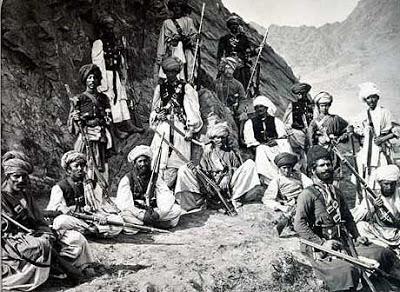
The First Attack on the Fort
Like wild hordes on the loose, the Pathans howling at top of their voices rode with guns blazing onto the Sikhs in order to breach the main gate of the post. One of the sepoys sounded the army trumpet as per Havildaar Ishar Singh's command and in a flash they formed up two lines, one row in a squatting firing position and the other standing. With only having a few months of having been given a new type of rifle which was capable of firing ten rounds of 303 calibre bullets a minute, it proved to be more than a match to the muzzle loading rifles possessed by the tribesmen. Tribal leaders called for the Sikhs to surrender as their fight was the British and not with the Sikhs, however Havildaar Ishar Singh, a fearless Gursikh, just stared back at them with his piercing eyes.
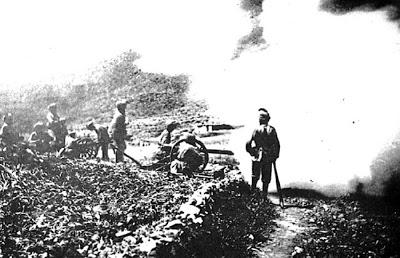
The Sikh's Fire Bullets
The effective range of the Henry Martini rifle was around 600 yards (550m). Havildaar Ishar Singh held his order to fire until the enemy closed in within 250m from his post. Once the Pathans breached this marker, he yelled: "NAA DARRO AR SIO JAB JAAE LARRO" and in a loud chorus all the soldiers repeated: "NISCHAI KAR APNEE JEEET KARO" ... With the effective firing-range the Sikhs destroyed the first line of the Pathan advance. However reloading the guns were time consuming. From atop the post, Havildaar Ishar Singh saw again thousands of Pathans in rows upon rows, waiting to charge against them. Now the Pathans knew the actual strength of the Sikhs and planned for a massive assault on all flanks, a multi-pronged attack designed to divide the outnumbered Sikhs into much smaller groups thereby ensuring weaker defensive formations.

Second-Attack on the Fort
The attack this time was with such fury that the earth around the fort shook as the Pathan horsemen thundered across the barren land to slice the Sikhs into pieces. Havildaar Ishar Singh, unnerved by this onslaught, gave battle orders again: "SQUATTING SOLDIERS TO THE RIGHT ... STANDING SOLDIERS TO THE LEFT ... QUICKLY ... QUICKLY...", with clarity amid the chaos of battle. The highly disciplined Sikh soldiers followed the orders like clock-work. The tribesmen attacked in two formations, one towards the main gate and the other towards the gap at the fort. Havildaar Ishar Singh calculated that at least 150 tribesmen rode in this wave. He could see only the white of their eyes as the tribesmen approached closer, masking their faces. Undeterred, he and the other 20 soldiers roared like thunder, "BOLE SO NIHAL ... SAT SRI AKAAL!". The tribesmen's attack was repulsed once again by the Sikhs due to superior marksmanship and motivation but the soldiers' ranks and ammunitions also started to dwindle.

10 Soldiers Left
From 9am to 12pm the Sikhs had been charged at seven times and had been now left with 10 soldiers led by the wounded Havildaar Ishar Singh, who despite being injured by bullets and saber slashes continued his duties. The ammunition gradually finished and by 2pm, Sepoy Gurmukh Singh signalled Fort Lockhart Battalion HQ: "LOW ON AMMO ... NEED AMMO ... URGENTLY!". Lt Col Haughton sent some men to try and pass the ammunition to the trapped Sikhs, but again to no avail. As the Pathans attacked again, the 10 Sikhs repelled them back once again. The tribesmen now resorted to sitting fire to the bushes and scrubs around Fort. With the thick smoke the Sikhs could not see the enemy. The Battalion HQ in Fort Lockhart could clearly see the tribesmen approaching the breach in the fort due to their elevated position above Saragarhi. Lt Col Haugton frantically signalled Saragarhi: "ENEMY APPROCHING THE BREACH ...!" Havildaar Ishar Singh, due to injuries sustained, had to drag himself towards the breach, accompanied by two other soldiers, to stop the tribesmen from entering the fort. Out of ammunition, all three of them fixed their bayonets and charged the tribesmen. Overwhelmed by the sheer numbers facing them, all three fell were they stood bravely. At the same time, the tribesmen entered the main gate due to the thinning of the defensive lines. However, hand to hand fighting still took place inside the fort, in full view from Fort Lockhart.

Four Sikhs Left
Only 4 Sikhs were alive by the time the tribesmen breached the fort, with an additional soldier, Gurmukh Singh, in the nearby mound providing up to date situation report via heliograph. Out of ammunition, they did not lay down their weapons; instead, they formed an all round defensive position with their backs against each other, their bayonets pointing outwards. A force of nearly a hundred Pathans hacked the valiant Sikhs into pieces, but not before the Sikhs took a few heads with them. From Lockhart, soldiers were in utter disbelief of the raw courage displayed down below at Saragarhi and the stiff resistance put up by the remaining Sikhs. They simply gasped in awe of the action unfolding before their very eyes.
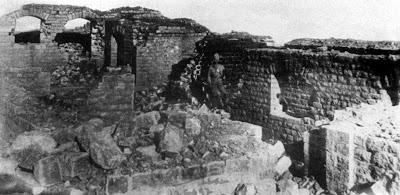
One Sikh Left
At 3.30pm Sepoy Gurmukh Singh transmitted: "MAIN GATE BREACHED ... DOWN TO ONE ... REQUEST PERMISSION TO DISMOUNT AND JOIN THE FIGHT ...!" Orders came back: "PERMISSION GRANTED!" 19-year old Gurmukh Singh disassembled his heliograph device, picked up his rifle and bravely went into the fort to join the fight. Soldiers at Fort Lockhart saw him disappear into the thick of the battle, right into the tribesmen line. They could only hear him roaring at the top of his voice: "JO BOLE SO NIHAAL ... SAT SRI AKAAL! ... JO BOLE SO NIHAAL, SAT SRI AKAAL...!" The third battle cry grew even more weaker, whilst Gurmukh Singh began choking on his blood as he stood there, bayoneting. Legend has it that he took down single-handedly 20 tribesmen before succumbing to the repeated slashes of the tribesmen's swords and the fire that was engulfing the post. Twitching, as his last breath left him, Sepoy Gurmukh Singh could hear in his mind the melodic Shabad of "DUKH BHANJAN" his mother had recited every evening in their home. He died, satisfied in the knowledge that he had done his duty and lived to his last breath with Kesh (hair) intact!
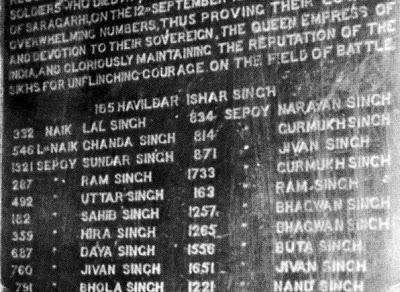
The Aftermath
Without the stiff resistance of the 21 Sikh soldiers at Saragarhi, both Fort Lockhart and Gulistan would have fallen to the enemy. By defending their position long enough for the relief column to arrive with artillery support, the 21 Sikh soldiers became the crucial factor in turning the tide of battle in their favour.The 21 Sikh soldiers fought on continuously for 7 punishing hours without food and water, completely surrounded, and pounded from all flanks. Unwearied by constant charges and mortal danger, they stood their ground against daunting odds, they repealed wave after wave of attack and fought till their last bullets. Even when out of ammunition, they did not abandon their post and instead chose to engage in a fatal hand to hand combat, till all made the ultimate sacrifice. When the relief column arrived a day later, they saw the burnt out bodies of all the 21 Sikh soldiers, together with at least 600 dead bodies of the tribesmen strewn only yards in front of their position.
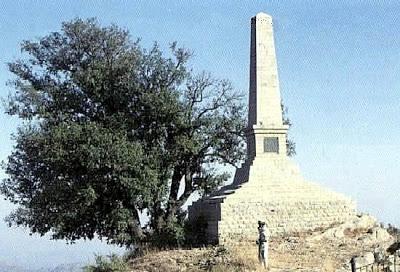
News of Bravery Spreads
LT Col Haughton signaled his HQ in Punjab about the battle that had transpired. Within a few hours, tales of their bravery were making news across India. The Governor General of India, the Earl of Elgin, wrote a personal telegraph to Queen Victoria describing the bravery of the Sikhs soldiers defending the post till their death. The news reached the British House of Commons, and the tales of sacrifice of the 21 Sikh soldiers were narrated. At the end the of Chief Whip's speech, the entire parliament gave a rousing standing ovation to the Gallant 21 Sikhs, as their names were called out aloud in a symbolic roll call. The collective courage of the 21 Sikh soldiers moved Queen Victoria so much that she awarded the 21 Sikhs with the Indian Order Merit (IOM), which is the highest award for bravery given to colonial troops and it was equivalent to the British Victoria Cross. This was the only time in history of warfare where each soldier who took part in the same battle was given the highest award. Additionally, the Queen awared their next of kin with 500 rupees and 50 acres of land. Finally, a memorial cenotaph was to be erected near the place where all these 21 soldiers fell, as a perpetual record to the heroic action of these gallant soldiers.
12th September marks the Battle of Saragarhi that took place in 1897. It is the incredible story of 21 Sikh soldiers against the ferocious Pathan (Afghan) tribesmen, numbering close to 10,000. The staggering ratio of 1: 416 stacked against the Sikhs was both unmatched and unprecedented, making their "last stand" at Saragarhi as the greatest odds faced by any troops in the history of modern warfare. The Battle at Saragarhi is one of eight stories of collective bravery published by UNESCO (United Nations Educational, Scientific and Cultural Organization). It has been mentioned as one of the five most significant events of its kind in the world which includes the Saga of Thermoplyae associated with the heroic stand of a small Greek force against the mighty Persian Army of Xerxes in 480 B.C.
The Battle of Saragarhi
12th September marks the Battle of Saragarhi that took place in 1897. It is the incredible story of 21 Sikh soldiers against the ferocious Pathan (Afghan) tribesmen, numbering close to 10,000. The staggering ratio of 1: 416 stacked against the Sikhs was both unmatched and unprecedented, making their "last stand" at Saragarhi as the greatest odds faced by any troops in the history of modern warfare. The Battle at Saragarhi is one of eight stories of collective bravery published by UNESCO (United Nations Educational, Scientific and Cultural Organization). It has been mentioned as one of the five most significant events of its kind in the world which includes the Saga of Thermoplyae associated with the heroic stand of a small Greek force against the mighty Persian Army of Xerxes in 480 B.C.
A Glimpse at the Story of the Battle of Saragarhi

Saragarhi
Saragarhi was a communication relay post between Fort Lockhart and Fort Gulistan in the Sulaiman Range of the North Western Front Province. Since Lockhart and Gulitsan were not in a visual line of sight due to geographical attributes, a midway heliograph communication post (communication by capturing sunlight with a mirror and transmitting it via coded messages) was built at Saragarhi. The Saragarhi post was vital in ensuring the survival of these two Forts in specific and the defence of the region, in general.

Resistance from Local Tribes
The last decades of the 19th century the Russians were trying to make inroads into the Indian continent via Afghanistan and the British had to make several incursions into Afghanistan to prevent Afghan tribes allied with the Russian from taking over. In order to this the British used posts constructed by Maharaja Ranjit Singh, during his Western campaign. Constant raids and skirmishes by violent and bloodthirsty tribesmen were a regular occurrence and the British Indian Army was in constant vigil. Castration, mutilation and skinning captured soldiers alive was one of the many ways tribal leaders instilled fear and control.

Sikhs Soldiers in the British Army
The relationship between the Sikh soldiers and the British Army started out of mutual admiration for each others' courage and tenacity in the battle during the First Anglo-Sikh War (1839-45) and the Second Anglo-Sikh War (1845-49). The inclusion of Sikh soldiers in the British Army was a testament to that admiration. The British recognised that the bravery, honesty, integrity, and fearlessness of the Sikh soldiers came from their faith, the Amrit they had taken and the Rehit (code of conduct) thay lived by, and therefore only Amritdhari Sikhs who prescribed to Rehit were enrolled in the army.

Plan for Attack
Before 12th September, numerous attempts were made by the Pathans to overrun the post but they failed due to calculated defensive actions by the Sikhs under the able leadership of Havildaar Ishar Singh, the detachment commander at Saragarhi. Unknown to the Sikhs, the Pathans were planning a major attack set for 12th September 1897 at 9am to destroy this vital post. The Pathan strategy was to block the reinforcement from Fort Lockhart and strike Saragarhi with no mercy. Havildaar Ishar Singh peered through his binoculars from the watch tower of his post. Through the magnified view, he could see columns upon columns and row upon rows of Pathans waving their swords and guns violently at the Sikhs. The dust kicked up by the thousands of horses temporarily blocked the sun rising over the horizon. The Pathan forces assembled before the Sikhs who were raring to go.

Call for Back-up
Sepoy Gurmukh Singh, the detachment signaller, began signalling to Fort Lockhart about their position: "ENEMY APPROACHING THE MAIN GATE ... NEED REINFORCEMENT". Lt Col Haughton, Commanding Officer of 36th Sikh Battalion, rushed his troops to help the outnumbered Sikhs but the Pathans had cut-off the supply route between Fort Lockhart and Saragarhi so that the Sikhs would be stangled into submission. Fort Lockhart transmitted back: "UNABLE TO BREAKTHROUGH ... HOLD POSITION". Saragarhi flashed back: "UNDERSTOOD". With that message, Lt Col Haughton had sealed the faith of the Sikhs at Saragarhi to certain death. As he watched from Fort Lockhart, Haugthon with his own eyes counted at least 10 enemy standards (each representing 1,000 tribesmen) facing the 21 Sikh soldiers.

The First Attack on the Fort
Like wild hordes on the loose, the Pathans howling at top of their voices rode with guns blazing onto the Sikhs in order to breach the main gate of the post. One of the sepoys sounded the army trumpet as per Havildaar Ishar Singh's command and in a flash they formed up two lines, one row in a squatting firing position and the other standing. With only having a few months of having been given a new type of rifle which was capable of firing ten rounds of 303 calibre bullets a minute, it proved to be more than a match to the muzzle loading rifles possessed by the tribesmen. Tribal leaders called for the Sikhs to surrender as their fight was the British and not with the Sikhs, however Havildaar Ishar Singh, a fearless Gursikh, just stared back at them with his piercing eyes.

The Sikh's Fire Bullets
The effective range of the Henry Martini rifle was around 600 yards (550m). Havildaar Ishar Singh held his order to fire until the enemy closed in within 250m from his post. Once the Pathans breached this marker, he yelled: "NAA DARRO AR SIO JAB JAAE LARRO" and in a loud chorus all the soldiers repeated: "NISCHAI KAR APNEE JEEET KARO" ... With the effective firing-range the Sikhs destroyed the first line of the Pathan advance. However reloading the guns were time consuming. From atop the post, Havildaar Ishar Singh saw again thousands of Pathans in rows upon rows, waiting to charge against them. Now the Pathans knew the actual strength of the Sikhs and planned for a massive assault on all flanks, a multi-pronged attack designed to divide the outnumbered Sikhs into much smaller groups thereby ensuring weaker defensive formations.

Second-Attack on the Fort
The attack this time was with such fury that the earth around the fort shook as the Pathan horsemen thundered across the barren land to slice the Sikhs into pieces. Havildaar Ishar Singh, unnerved by this onslaught, gave battle orders again: "SQUATTING SOLDIERS TO THE RIGHT ... STANDING SOLDIERS TO THE LEFT ... QUICKLY ... QUICKLY...", with clarity amid the chaos of battle. The highly disciplined Sikh soldiers followed the orders like clock-work. The tribesmen attacked in two formations, one towards the main gate and the other towards the gap at the fort. Havildaar Ishar Singh calculated that at least 150 tribesmen rode in this wave. He could see only the white of their eyes as the tribesmen approached closer, masking their faces. Undeterred, he and the other 20 soldiers roared like thunder, "BOLE SO NIHAL ... SAT SRI AKAAL!". The tribesmen's attack was repulsed once again by the Sikhs due to superior marksmanship and motivation but the soldiers' ranks and ammunitions also started to dwindle.

10 Soldiers Left
From 9am to 12pm the Sikhs had been charged at seven times and had been now left with 10 soldiers led by the wounded Havildaar Ishar Singh, who despite being injured by bullets and saber slashes continued his duties. The ammunition gradually finished and by 2pm, Sepoy Gurmukh Singh signalled Fort Lockhart Battalion HQ: "LOW ON AMMO ... NEED AMMO ... URGENTLY!". Lt Col Haughton sent some men to try and pass the ammunition to the trapped Sikhs, but again to no avail. As the Pathans attacked again, the 10 Sikhs repelled them back once again. The tribesmen now resorted to sitting fire to the bushes and scrubs around Fort. With the thick smoke the Sikhs could not see the enemy. The Battalion HQ in Fort Lockhart could clearly see the tribesmen approaching the breach in the fort due to their elevated position above Saragarhi. Lt Col Haugton frantically signalled Saragarhi: "ENEMY APPROCHING THE BREACH ...!" Havildaar Ishar Singh, due to injuries sustained, had to drag himself towards the breach, accompanied by two other soldiers, to stop the tribesmen from entering the fort. Out of ammunition, all three of them fixed their bayonets and charged the tribesmen. Overwhelmed by the sheer numbers facing them, all three fell were they stood bravely. At the same time, the tribesmen entered the main gate due to the thinning of the defensive lines. However, hand to hand fighting still took place inside the fort, in full view from Fort Lockhart.

Four Sikhs Left
Only 4 Sikhs were alive by the time the tribesmen breached the fort, with an additional soldier, Gurmukh Singh, in the nearby mound providing up to date situation report via heliograph. Out of ammunition, they did not lay down their weapons; instead, they formed an all round defensive position with their backs against each other, their bayonets pointing outwards. A force of nearly a hundred Pathans hacked the valiant Sikhs into pieces, but not before the Sikhs took a few heads with them. From Lockhart, soldiers were in utter disbelief of the raw courage displayed down below at Saragarhi and the stiff resistance put up by the remaining Sikhs. They simply gasped in awe of the action unfolding before their very eyes.

One Sikh Left
At 3.30pm Sepoy Gurmukh Singh transmitted: "MAIN GATE BREACHED ... DOWN TO ONE ... REQUEST PERMISSION TO DISMOUNT AND JOIN THE FIGHT ...!" Orders came back: "PERMISSION GRANTED!" 19-year old Gurmukh Singh disassembled his heliograph device, picked up his rifle and bravely went into the fort to join the fight. Soldiers at Fort Lockhart saw him disappear into the thick of the battle, right into the tribesmen line. They could only hear him roaring at the top of his voice: "JO BOLE SO NIHAAL ... SAT SRI AKAAL! ... JO BOLE SO NIHAAL, SAT SRI AKAAL...!" The third battle cry grew even more weaker, whilst Gurmukh Singh began choking on his blood as he stood there, bayoneting. Legend has it that he took down single-handedly 20 tribesmen before succumbing to the repeated slashes of the tribesmen's swords and the fire that was engulfing the post. Twitching, as his last breath left him, Sepoy Gurmukh Singh could hear in his mind the melodic Shabad of "DUKH BHANJAN" his mother had recited every evening in their home. He died, satisfied in the knowledge that he had done his duty and lived to his last breath with Kesh (hair) intact!

The Aftermath
Without the stiff resistance of the 21 Sikh soldiers at Saragarhi, both Fort Lockhart and Gulistan would have fallen to the enemy. By defending their position long enough for the relief column to arrive with artillery support, the 21 Sikh soldiers became the crucial factor in turning the tide of battle in their favour.The 21 Sikh soldiers fought on continuously for 7 punishing hours without food and water, completely surrounded, and pounded from all flanks. Unwearied by constant charges and mortal danger, they stood their ground against daunting odds, they repealed wave after wave of attack and fought till their last bullets. Even when out of ammunition, they did not abandon their post and instead chose to engage in a fatal hand to hand combat, till all made the ultimate sacrifice. When the relief column arrived a day later, they saw the burnt out bodies of all the 21 Sikh soldiers, together with at least 600 dead bodies of the tribesmen strewn only yards in front of their position.

News of Bravery Spreads
LT Col Haughton signaled his HQ in Punjab about the battle that had transpired. Within a few hours, tales of their bravery were making news across India. The Governor General of India, the Earl of Elgin, wrote a personal telegraph to Queen Victoria describing the bravery of the Sikhs soldiers defending the post till their death. The news reached the British House of Commons, and the tales of sacrifice of the 21 Sikh soldiers were narrated. At the end the of Chief Whip's speech, the entire parliament gave a rousing standing ovation to the Gallant 21 Sikhs, as their names were called out aloud in a symbolic roll call. The collective courage of the 21 Sikh soldiers moved Queen Victoria so much that she awarded the 21 Sikhs with the Indian Order Merit (IOM), which is the highest award for bravery given to colonial troops and it was equivalent to the British Victoria Cross. This was the only time in history of warfare where each soldier who took part in the same battle was given the highest award. Additionally, the Queen awared their next of kin with 500 rupees and 50 acres of land. Finally, a memorial cenotaph was to be erected near the place where all these 21 soldiers fell, as a perpetual record to the heroic action of these gallant soldiers.
